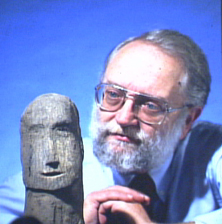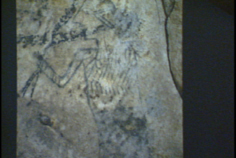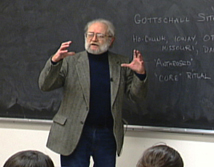 |
Dr.
Robert Salzer's archeological research at Gottschall
|
In Spring 2004, Dr. Robert Salzer gave a
lecture at the University of Illinois. Dr. Salzer is now a retired
professor of archeology who taught at Beloit College for 38 years,
during which time he directed 34 archeological field schools
for his students. His most famous research project is at the
Gotschall Site in Wisconsin. His ongoing research reveals that
this site contains a long series of human occupations going back
at least 1,200 years.
|
|
The cave contains artwork,
which depicts a number of characters found in contemporary
Ho-Chunk (Winnebago) oral tradition. |
Dr.
Salzer’s work with members
of the Ho-Chunk nation in Wisconsin illustrates the fruits
of collaboration between archeologists and Native Americans. |
|
|
|
Clip
1: Dr. Salzer introduces the Gotschall site, noting that
it was first thought to be
a shallow rock shelter. Using the Ho-Chunk Nation’s
Ground Penetrating Radar program, they discovered it was
actually a deeper cave. Dr. Salzer discusses the “disconnect” between
archeological knowledge and Native American perspectives.
Click here to view Clip 1.
|
Clip
2: Dr. Salzer introduces some technical terms –"anthrosed,"
and "core
ritual"–as well as the names of some of the
Indian nations of the area. He notes that the Ho-Chunk,
Ioway, Otoe & Missouri, and Dakota nations all speak
languages of the Siouan language family, in contrast to
the other nations of the region who speak languages of
the Algonquian family.
Click here to
view Clip 2.
|
 |
|
|
Clip
3: “What is a Cultural
Landscape?” Dr. Salzer discusses this term as a concept
that bridges the objectives of both anthropologists and
Native Americans. He describes the non-profit agency “Cultural
Landscape Legacies Inc” (clli.org) a collaborative
venture with the Ho-chunk nation....
Click here to
view Clip 3.
|
Clip
4: Dr. Salzer describes the Effigy Mound Tour –one
of the ventures of Cultural Landscape Legacies Inc. that
is strongly supported by the Ho-chunk
nation.
Click here to
view Clip 4.
|
|
|
|
Clip 5: Using slides taken inside
the Gotschall Cave, Dr. Salzer describes and explains their
exciting findings.
Click here to
view Clip 5.
|
Clip 6: The Gotschall site was later
vandalized by a looter, which provoked action by the Wisconsin
legislature to increase legal penalties for looting or
defacing ancient sites such as Gotschall.
Click here to
view Clip 6.
|
|
|
Clip
7: Dr. Salzer describes the techniques used to enhance
the badly eroded rock art in order to investigate
it further.
There appear to be human figures, animal figures and spiritual
beings represented. But how do we interpret it? The literature
of the Ho-Chunk and Ioway nations, written down by anthropologists
in the 19th century (in English and Ho-Chunk) provides
some clues – especially the Legend of Red Horn. Ho-Chunk
elders also visited the site and recognized the figures.
Click here to
view Clip 7. |
Clip 8: Dr. Salzer tells part of The Legend of Red Horn
and discusses linguistic contributions from Ho-Chunk elders
that shed light on the puzzle.
Click here to
view Clip 8. |
|
|
Clip 9: Another story -- Red Horn and his two friends,
Turtle and Storms-as-he-walks, confront giants.
Click here to
view Clip 9.
|
Clip 10: Dr. Salzer makes exciting connections between
the legends and the drawings in the Cave!
Click here to
view Clip 10.
|
|
Back to the Online Essays
|


